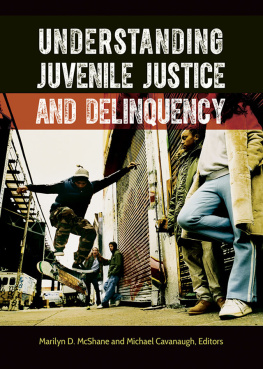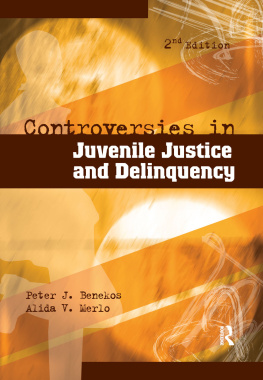Understanding Juvenile Justice and Delinquency
Understanding Juvenile Justice and Delinquency
Marilyn D. McShane and Michael Cavanaugh , Editors
Copyright 2016 by Marilyn D. McShane and Michael Cavanaugh
All rights reserved. No part of this publication may be reproduced, stored in a retrieval system, or transmitted, in any form or by any means, electronic, mechanical, photocopying, recording, or otherwise, except for the inclusion of brief quotations in a review, without prior permission in writing from the publisher.
Library of Congress Cataloging-in-Publication Data
Names: McShane, Marilyn D., 1956 editor. | Cavanaugh, Michael R., 1981 editor.
Title: Understanding juvenile justice and delinquency / Marilyn D. McShane and Michael Cavanaugh, editors.
Description: Santa Barbara, California: Praeger, [2016] | Includes bibliographical references and index.
Identifiers: LCCN 2015026427| ISBN 978-1-4408-3962-7 (hardback) | ISBN 978-1-4408-4359-4 (pbk) | ISBN 978-1-4408-3963-4 (ebk)
Subjects: LCSH: Juvenile justice, Administration ofUnited States. | Juvenile delinquencyUnited States. | Juvenile delinquents RehabilitationUnited States. | Juvenile correctionsUnited States. | BISAC: LAW / Child Advocacy. | LAW / Criminal Law / Juvenile Offenders.
Classification: LCC HV9104 .U475 2016 | DDC 364.360973dc23
LC record available at http://lccn.loc.gov/2015026427
ISBN: 978-1-4408-3962-7 (hardcover)
ISBN: 978-1-4408-4359-4 (paperback)
EISBN: 978-1-4408-3963-4
20 19 18 17 16 1 2 3 4 5
This book is also available on the World Wide Web as an eBook.
Visit www.abc-clio.com for details.
Praeger
An Imprint of ABC-CLIO, LLC
ABC-CLIO, LLC
130 Cremona Drive, P.O. Box 1911
Santa Barbara, California 93116-1911
This book is printed on acid-free paper 
Manufactured in the United States of America
In loving memory of James David Simonis (19852015)
Aunt Marilyn
To Sarah, my loving wife
Mike
Contents
| Alida V. Merlo and Peter J. Benekos |
| Ming Li Hsieh, Marilyn D. McShane, and Frank P. Williams III |
| Stephanie Fahy |
| Marcos Misis |
| Michael Cavanaugh |
| Traqina Emeka |
| Alexandria Pech and Barbara E. Bloom |
| Rebecca Pfeffer |
| Antonio Hernandez and Judith Harris |
| John K. Mooradian |
| Melanie Taylor |
| Clete Snell and Janet Eguzouwa |
| Ronald Burns and Kendra Bowen |
Part I
The Changing Boundaries of Juvenile Justice Issues
Preface to Part I: Perceiving is Believing
Tracing beliefs about the causes of delinquency over time, we find that theories ranged from demons and climate variations to glandular dysfunctions and a lack of wholesome recreational activities. Around the end of World War II, the editors of the Saturday Evening Post wrote that sinister effects on the behavior and character of Americas children constitute one of the greatest evils of this war. Statistics gathered from a number of places reveal a sharp nationwide increase in juvenile wrong-doing. It is no surprise, then, that the science of criminology and criminal justice is as interdisciplinary as it is controversial.
Todays juvenile delinquency textbooks devote multiple chapters to theories of causation. Biological, sociobiological, psychological, and sociological approaches embrace the latest technologies, testing methods, data sets, and discoveries. The evolution of theories reflects the practice of theory integration, as better data collection and analysis methods allow us to carry forward the best predictors and the most accurate descriptors. Above all, theorists today emphasize the complexity of delinquency that involves not only the overlap between victimization and offending but also the way the process of maturing over the life course impacts our associations and activities. Hopefully, this is something that you will take away from the chapters in this first part.
At this point it is also valuable to recognize that, despite the advances in theory and research, much of how we approach juvenile justice policy is based on personal beliefs about the causes of delinquency and anecdotal snippets of what might work for whom. Take a minute now to think about each of the factors listed in the following table that some consider to be related to delinquency. Do you think any of these are important as explanations of juvenile crime? As an exercise for approaching the chapters that will follow, take a few minutes to summarize how influential you think each factor is and explain how you think it plays a role in the development of juvenile delinquency, how that might be related to various types of crime, and how the process might work. A clear explanation might involve whether a factor is more influential under certain circumstances, more for some forms of crime, or for some types of people. After you fill in the grid, save a copy and compare it to how you view these factors at the end of the readings where we will visit this exercise again.
In this parts readings you will explore some of the most recent issues that shape the dynamic study of delinquency as well as the most contemporary explanations for them. We will look at how perceptions of offending and offenses are defined by the social context or the social reality of the current environment and how these might change over time as certain crime problems and their perceived priorities change.
Pre-test: Factors Possibly Related to Delinquency
| Factors | Amount and Nature of Influence on Delinquency |
|
| Poverty |
| Mental Illness |
| Low Education Level |
| Drug /Alcohol Abuse |
| Family Problems (fighting, divorce, criminal history) |
| Personality/Self-Esteem |
| Anger or Revenge |
| Peer Pressure |
| Bad Neighborhoods |
| Poor Parenting |
| Low Self-Control |
| Other |
Today, people receive information about crime from a variety of sources including personal experiences, family and friends, social and news media, and government data and agency reports. Many of these sources are colored by a political or economic agenda. In particular, this agenda allows them to create biased or filtered information in ways that support their cause or campaign. It can be argued, for example, that cyber-sexual exploitation has been sensationalized by the media in a way that often misrepresents what is, in fact, a relatively rare event. This form of bias occurs when incidents are reported in a way that suggests people are surprised that offenders have somehow adapted to and are exploiting a new and apparently successful means of committing offenses. Accounts seem to give one the impression that predatory behavior by sex offenders is increasing rather than the possibility that offenders are simply changing their modus operandi. This failure to clarify the context of crime, or compare incidence to the likelihood of other forms of victimization when weighted for frequency of use, suggests we have difficulty in seeing or understanding these new trends as a routine function of crime and as a function of lifestyle changes. Yet this is precisely how behaviors change and adapt to new situations; in other words, change and adaptation should be expected. Offenders have traditionally moved to newer and less easily detectable methods as potential victims alter the dynamics of interactions and become available and suitable as targets. Meanwhile law enforcement races to adjust to these changes and as it attempts to prevent further victimization. To criminologists this is a well-established and normal cycle of activity.








